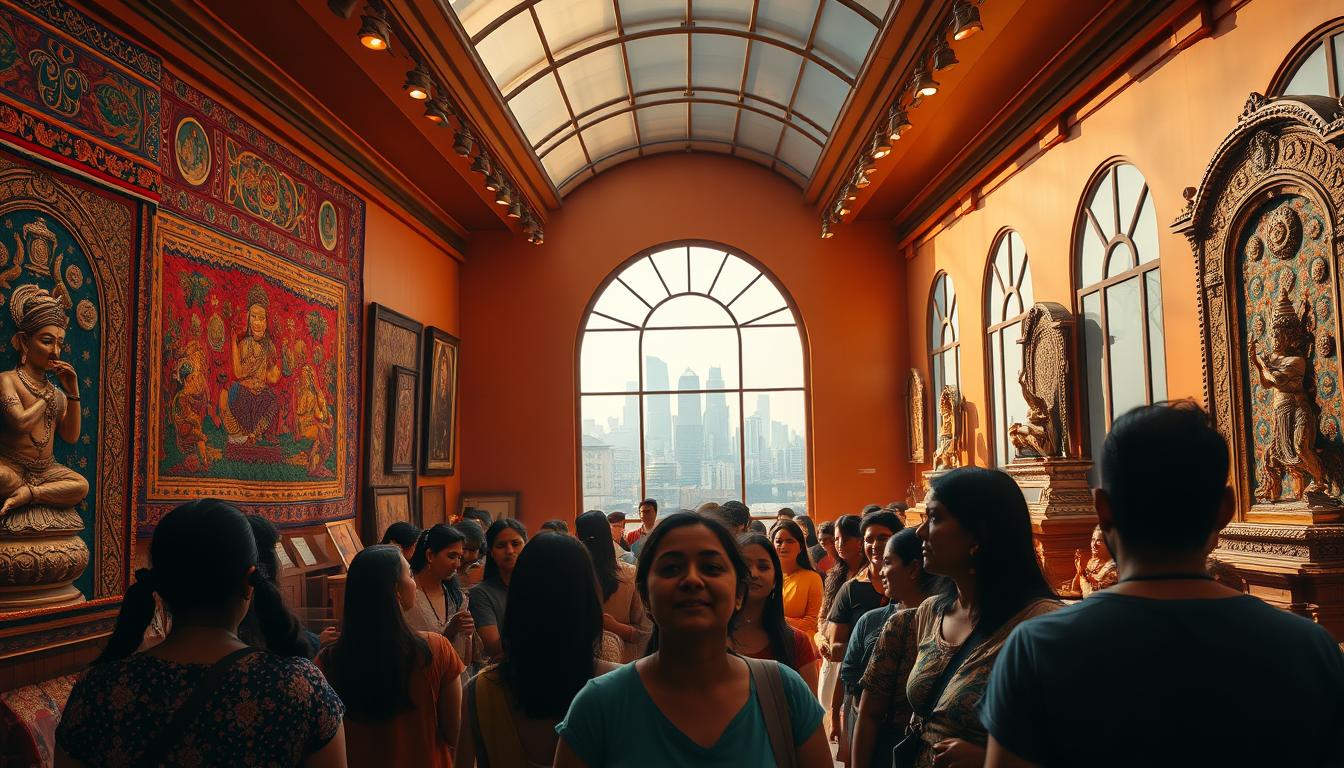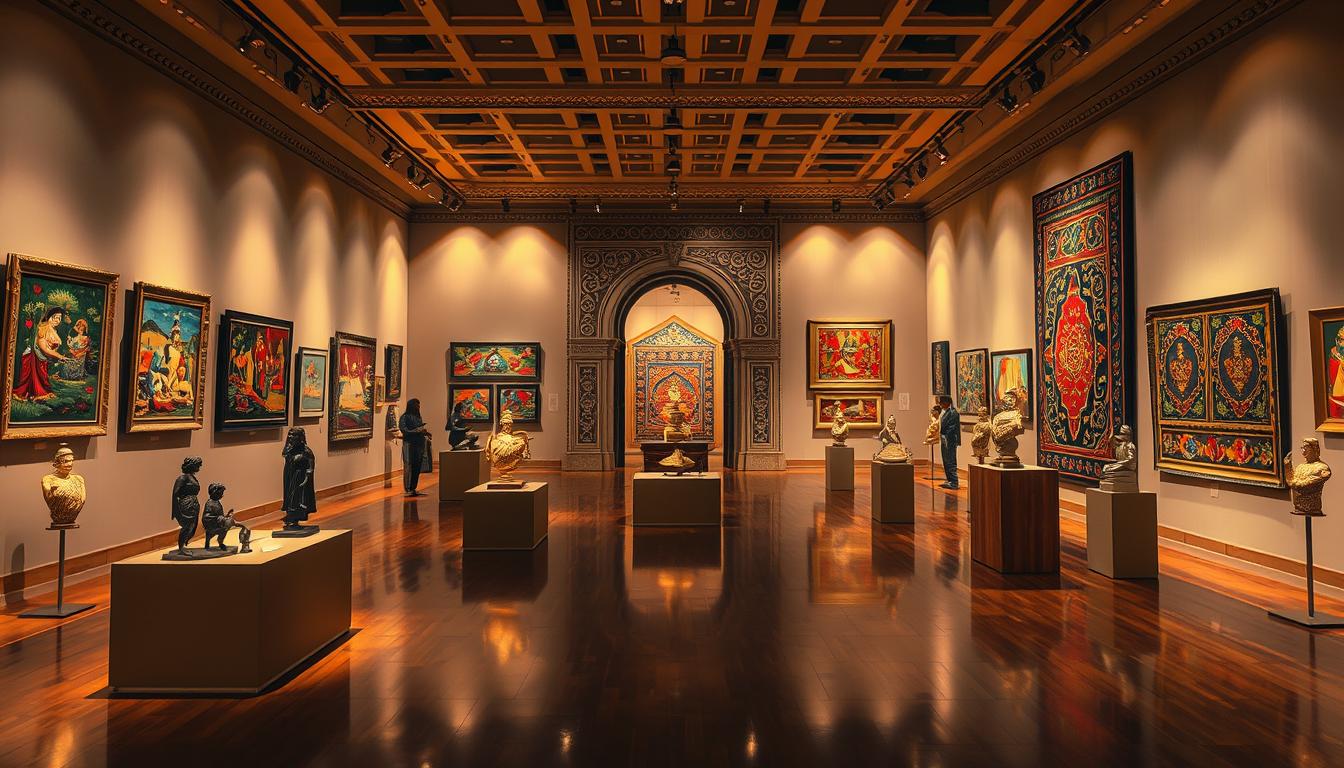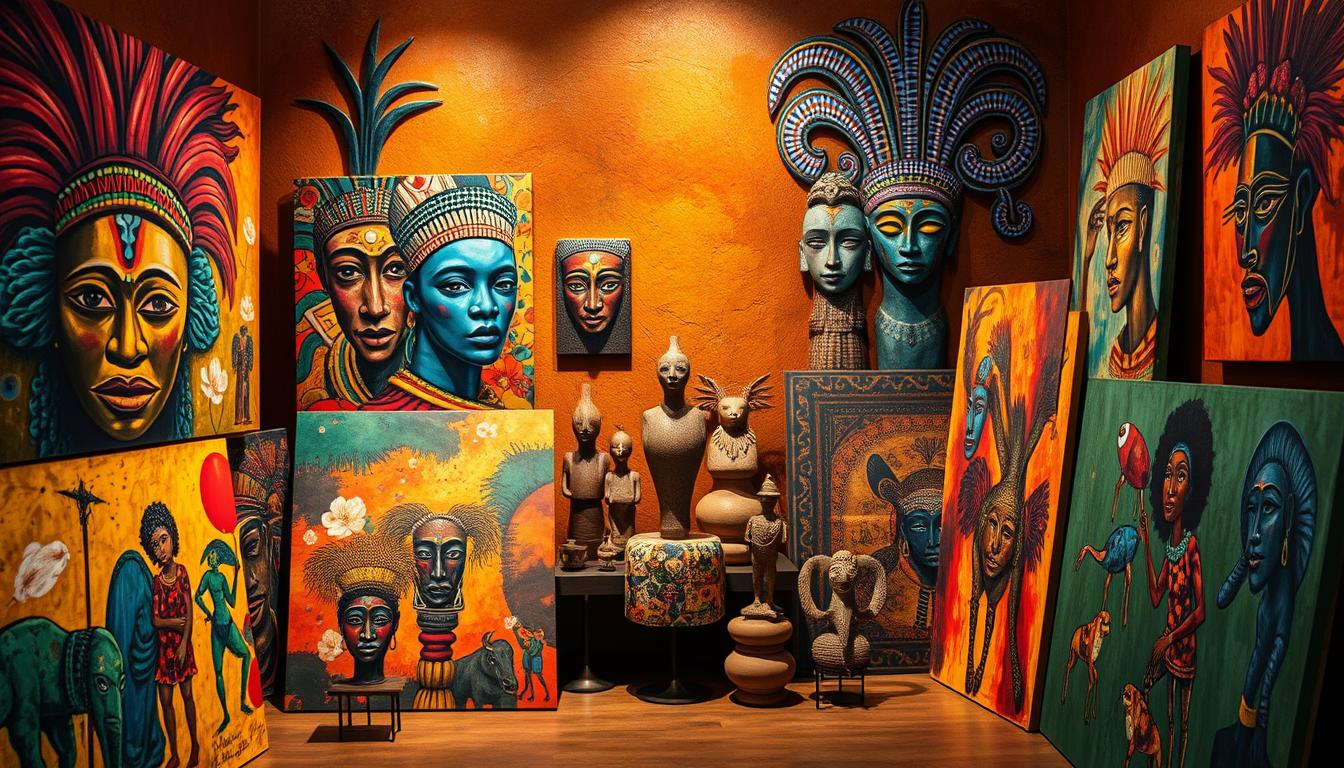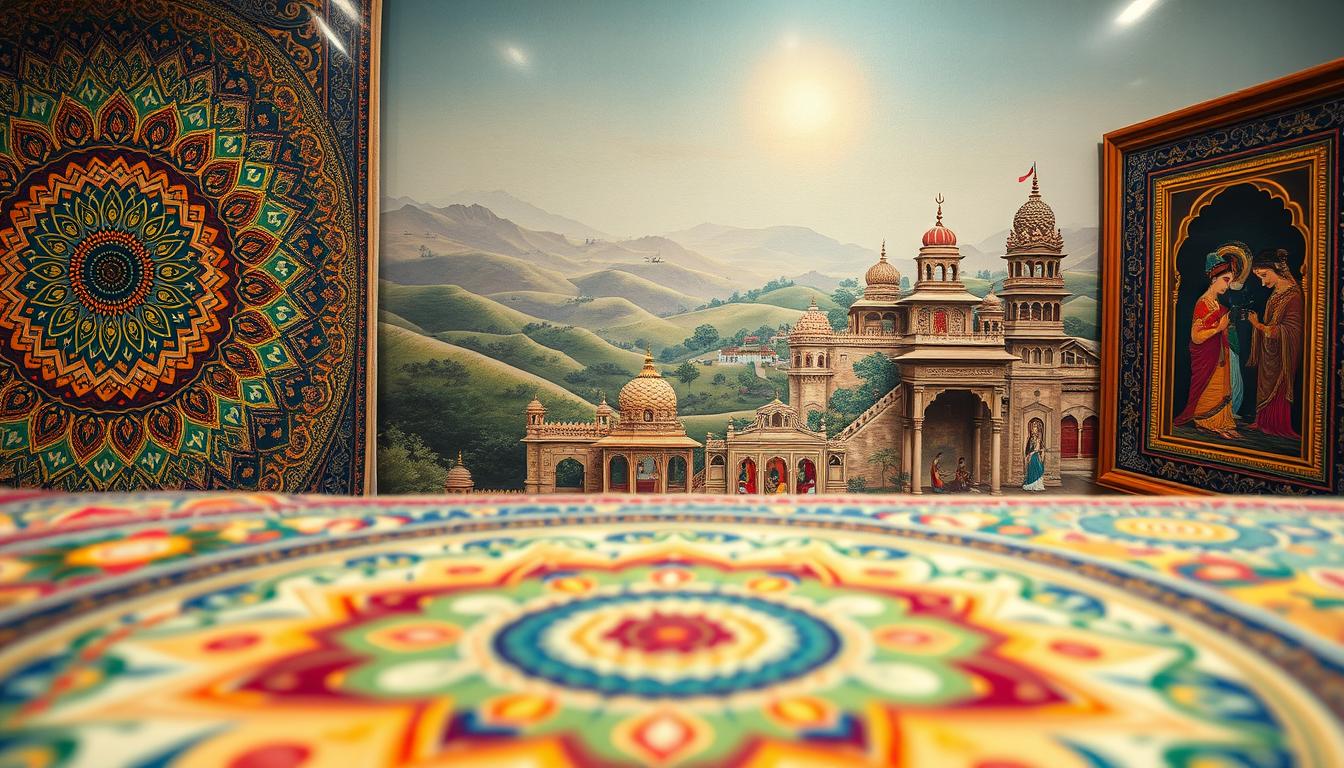I’ve always been amazed by Indian art’s deep wisdom and vibrant stories. Every brushstroke holds centuries of cultural knowledge. It’s a spiritual journey that connects us to India’s soul.
Indian art spans from Madhubani paintings in Bihar to Warli art in Maharashtra. These traditions show India’s rich cultural heritage. My journey into Indian art history has changed me, blending creativity with tradition.
Indian art is a mix of colors, techniques, and stories. Folk art’s geometric patterns and classical paintings’ mythological themes each share a unique story. They tell of human experiences, spiritual connections, and cultural identities.
Key Takeaways
- Indian art represents a rich, millennia-old cultural narrative
- Diverse artistic styles reflect regional and spiritual diversity
- Traditional art forms continue to inspire contemporary artists
- Each artwork is a window into India’s complex cultural heritage
- Indian art transcends aesthetic beauty, embodying philosophical insights
The Rich History of Indian Art
Indian art history is a vibrant tapestry of centuries of cultural expression and artistic brilliance. My journey through Indian art culture shows a story of creativity, resilience, and deep cultural significance.
The roots of Indian art go back thousands of years. Rock art at the Bhimbetka Rock Shelters shows early human societies’ artistic skills. Paintings there date back about 10,000 years.
Ancient Origins and Influences
India’s artistic legacy grew through many transformative periods:
- Indus Valley Civilization (2500-1900 BCE): Known for advanced sculptures and terracotta work
- Vedic Period: Art that symbolized complex religious practices
- Mauryan Empire: Famous for the Lion Capital of Sarnath
The Evolution Through the Ages
Each period brought new artistic developments. The Gupta Period was a golden age. Ajanta and Ellora caves show amazing Buddhist, Hindu, and Jain artworks. Later, the Mughal era brought detailed miniature paintings that mixed Indian and Persian styles.
Major Cultural Influences on Indian Art
Cultural interactions deeply shaped Indian art culture. Religious beliefs, foreign invasions, and trade routes enriched the artistic landscape. Buddhist, Hindu, Islamic, and colonial influences created a complex, inspiring heritage for today’s artists.
Indian art is not just a visual expression, but a living narrative of civilization’s most profound stories.
Traditional Indian Art Forms
India’s art scene is full of color and creativity. It shows the amazing diversity of traditional Indian paintings and rich folk art. Each area has its own special way of expressing art, telling stories of culture and human life.
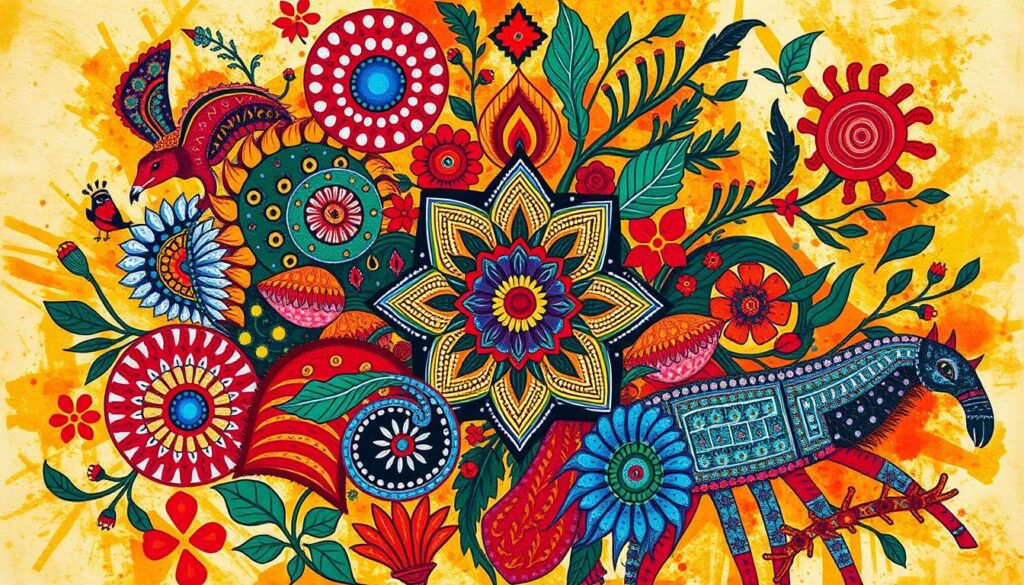
Indian art is incredibly varied, with many forms telling different stories. Let’s explore some of the most interesting traditions that have shaped India’s art world.
Folk Art: A Vibrant Expression
Folk art in India is a true way of storytelling. It shows the real life of rural areas and cultural traditions. Some standout folk art styles include:
- Madhubani painting from Bihar, featuring geometrical shapes and nature themes
- Warli art from Maharashtra, depicting daily life using minimalistic shapes
- Gond painting from Madhya Pradesh, illustrating folklore with natural colors
- Pattachitra from Orissa, showing mythological stories
Classical Dance and Performance Art
Performance arts in India are more than just dance. They are storytelling traditions. Classical dances like Bharatanatyam and Kathak tell ancient stories through beautiful movements.
Textile Arts: Weaving Stories Through Fabric
Textile arts are a deep part of Indian art. Techniques like Kalamkari and Bandhani turn fabrics into art, adding cultural meaning to every thread and pattern.
Art in India is not just a visual experience but a profound cultural dialogue passed through generations.
Regional Variations in Indian Art
India’s art scene is a colorful mix of different styles. Each part of the country has its own way of telling stories through art. This shows the deep cultural heritage that covers thousands of miles.
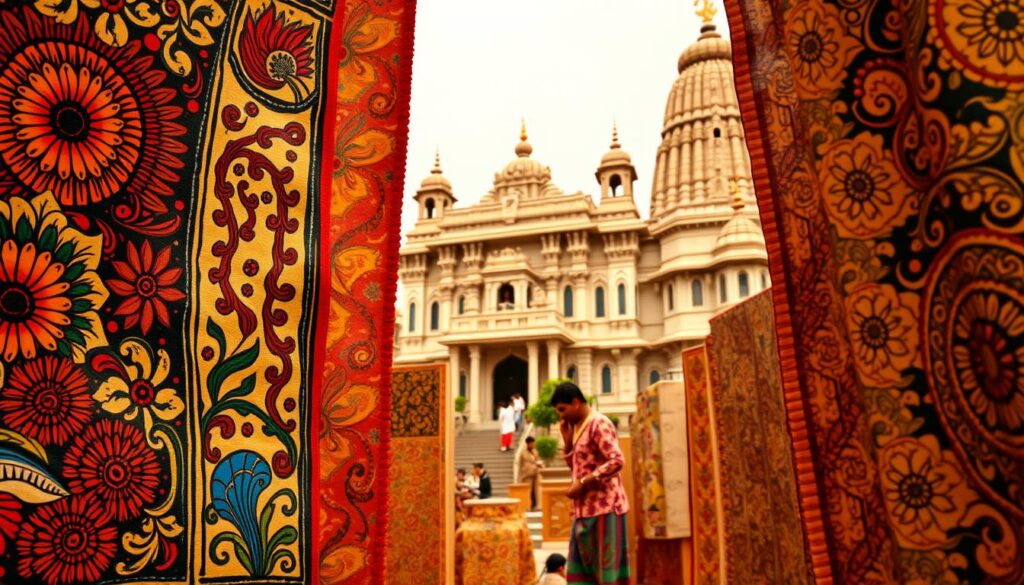
Let’s explore the world of Indian art together. We’ll see how each region has its own special art traditions.
Northern Artistic Expressions
The north of India is full of artistic variety. In Rajasthan, Madhubani paintings are famous for:
- Geometric patterns
- Mythological themes
- Intricate storytelling through art
Southern Indian Artistic Identity
The south of India adds its own magic to Indian art. It’s known for:
- Vibrant Kerala murals
- Intricate Chola bronze sculptures
- Kalamkari paintings from Andhra Pradesh
Eastern and Western Artistic Traditions
From Bastar’s tribal art in Chhattisgarh to Gujarat’s textile traditions, each area adds its own flavor. Warli art from Maharashtra is known for its simple yet powerful tribal life stories.
The beauty of Indian art lies in its ability to transform local stories into universal visual experiences.
Indian art keeps growing, mixing old ways with new ideas. This makes it ever-changing and always interesting.
The Role of Religion in Indian Art
Religion has always been at the heart of Indian art. It has created beautiful stories through art that has lasted for thousands of years. Looking into Indian art history shows how faith has deeply influenced art, turning simple materials into powerful stories.
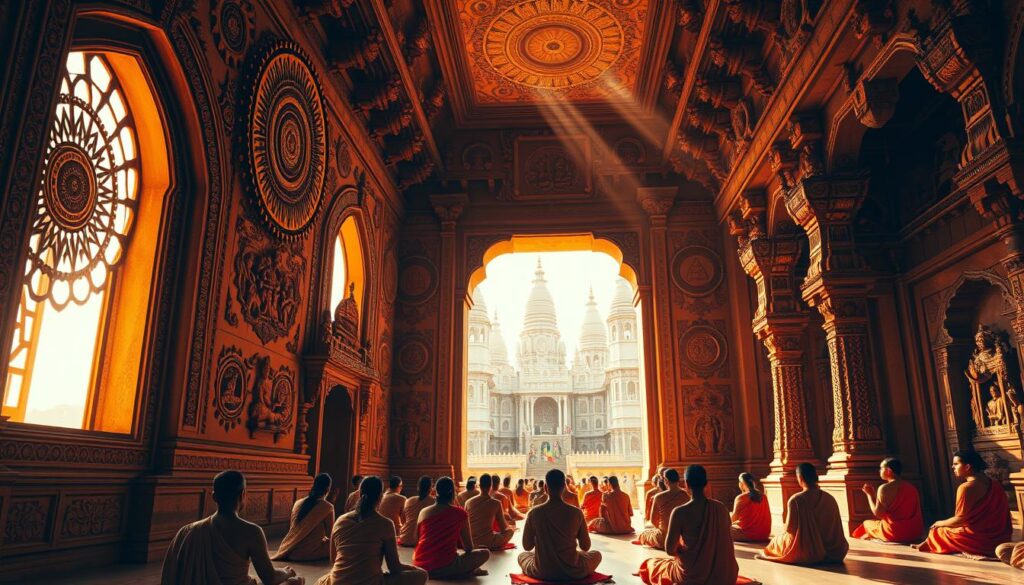
The art of India is filled with religious symbols. Religious iconography tells us a lot about the spiritual world of India. Each piece of art has deep meanings that go beyond just looking at it.
Hinduism’s Divine Artistic Language
Hindu art has its own special way of showing gods and goddesses. They are shown with:
- Multiple arms to show great power
- Big eyes to show they are special
- Colors and patterns that are full of life
Buddhist Artistic Symbolism
Buddhist art uses subtle signs to share deep wisdom. The iconographic representations often include:
- Long earlobes to show royal blood
- Head lumps for divine knowledge
- Positions that show calm and focus
Islamic Artistic Traditions
The Mughal era brought new art styles to India. They mixed Persian and local art. Miniature paintings showed detailed scenes of life, showing the mix of cultures in Indian art.
Indian Contemporary Art Scene
The world of contemporary Indian art has changed a lot after 1991. Artists now tell powerful stories and break new ground. They share the complex stories of modern India.
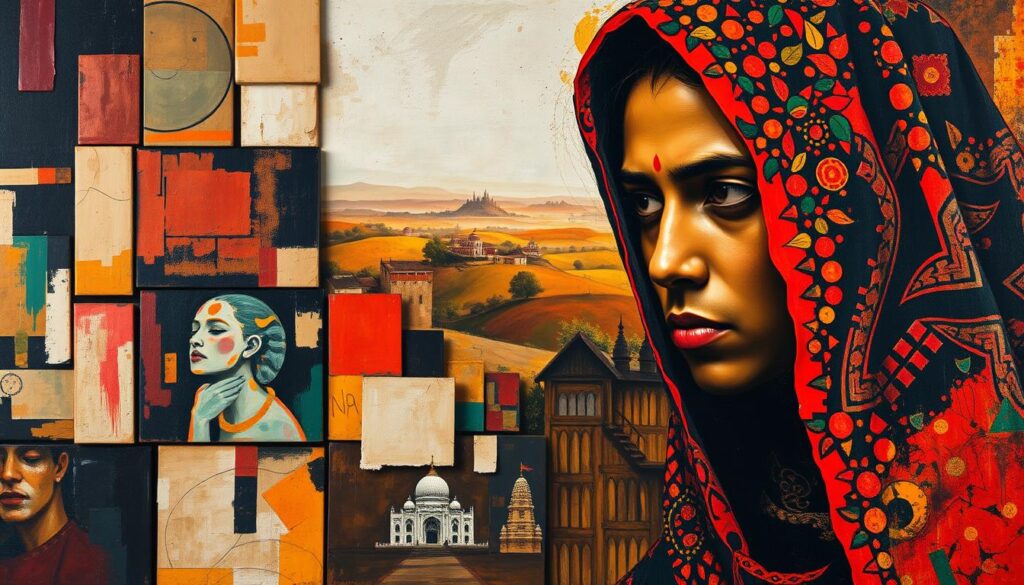
Today’s Indian art mixes old techniques with new ideas. Artists tackle many themes, from social issues to personal stories. This makes for a lively and thought-provoking art world.
Introduction to Modern Indian Artists
Some top Indian artists are known worldwide for their bold work:
- Subodh Gupta – Turns everyday items into deep art messages
- Mithu Sen – Uses art to challenge social norms
- Nalini Malani – Looks at gender and colonial history
Trends in Contemporary Art
Indian art trends show a few big changes:
- More art is seen globally at big fairs
- Art tackles big social and political issues
- Artists mix old and new ways of making art
- They also use digital and multimedia art
Fusion of Traditional and Modern Techniques
Artists cleverly mix old Indian art styles with new ones. This way, they make contemporary Indian art that honors tradition but also tackles today’s big issues.
Modern Indian art is not just about looks, but about telling strong stories that connect with people everywhere.
The Indian art market is growing fast. Big shows like the Kochi-Muziris Biennale and India Art Fair highlight the amazing talent in this lively art scene.
Famous Indian Artists and Their Contributions
The world of Indian art is full of vibrant colors and stories. Extraordinary artists have woven a tapestry of creativity and cultural expression. From traditional paintings to modern art, they have made a lasting impact on the global art scene.
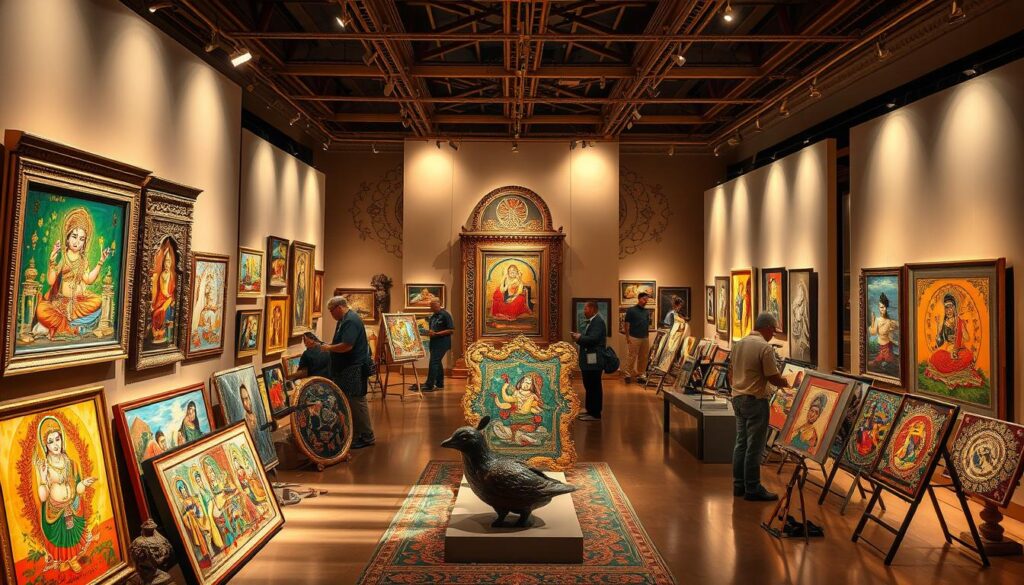
Exploring India’s artistic landscape, I found three key artists. They changed how we see visual stories:
Raja Ravi Varma: Pioneering Modern Indian Painting
Raja Ravi Varma was a game-changer in Indian art. He mixed European techniques with Indian themes. His work included:
- Bringing mythological stories to life with realistic paintings
- Introducing oil painting to Indian art
- Creating lasting images of Hindu gods and legends
Amrita Sher-Gil: A Trailblazing Feminist Artist
Amrita Sher-Gil was a force in modern Indian art. Her work showed deep human emotions. She focused on:
- The lives of women
- Complex cultural stories
- Using bright colors to show emotions
Subodh Gupta: Contemporary Art’s Innovative Voice
Subodh Gupta brings a fresh spirit to modern Indian art. His work turns everyday objects into powerful art. He explores:
- Identity and global changes
- The changing city
- How culture changes through objects
These artists have done more than create art. They’ve told stories that connect us across time. They blend old traditions with new ideas.
Indian Art in Global Context
Indian art has made a big splash worldwide, crossing borders and winning hearts. My journey through Indian art’s global story shows a tale of cultural sharing and creativity.
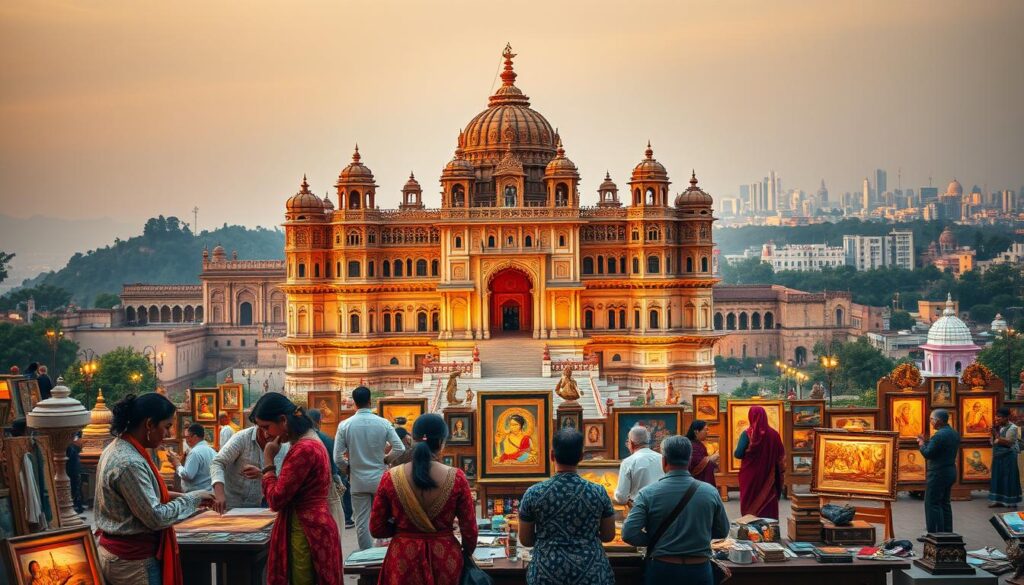
The Indian art market has seen huge growth, starting in the early 2000s. Big names like Sotheby’s and Christie’s have helped put Indian art on the world map. They’ve opened doors for artists to share their work.
The Impact of Indian Art Worldwide
Today, Indian artists are big names globally. They’re known for:
- Being seen more in international galleries
- Being sought after by the Indian diaspora
- Exploring new digital and installation art
Indian Art Exhibitions and Biennales
Indian art is now seen on big global stages. Artists like Subodh Gupta and Shilpa Gupta have changed how we see Indian art galleries. They use everyday things and new methods to share powerful stories.
Cross-Cultural Collaborations in Art
Art that crosses cultures is becoming more common. Artists are tackling big themes like identity, migration, and global worries. This has made Indian art a vibrant, changing part of global art.
Art Collecting and Investing in Indian Art
Exploring Indian art collecting is thrilling for both art lovers and investors. The Indian art market has grown fast, with a 12% annual growth rate for ten years. Learning about collecting can turn your hobby into a smart investment.
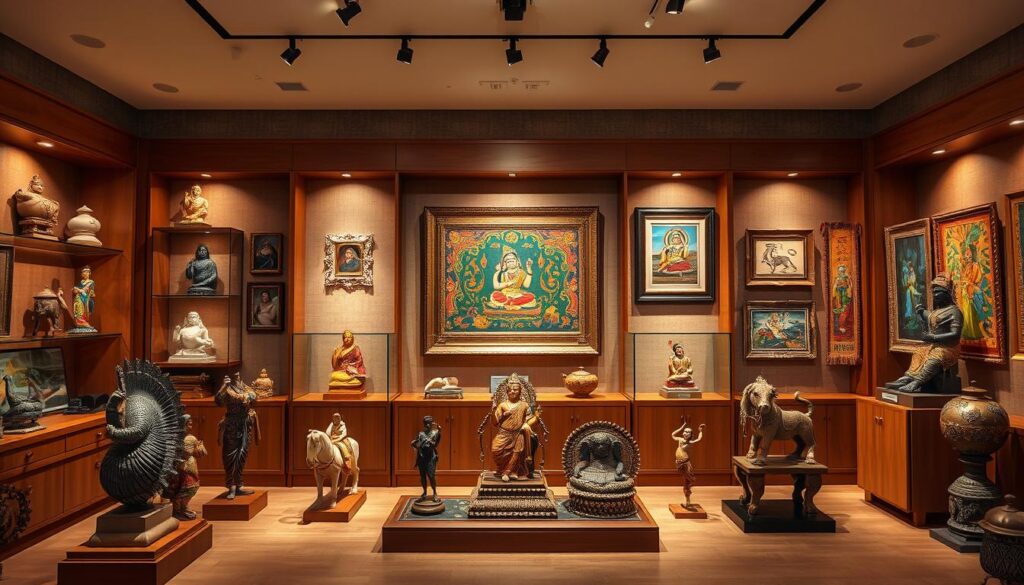
When you start collecting Indian art, you need a plan and good choices. Here are the first steps:
- Know what art you like and how much you can spend
- Look into the latest trends in Indian art
- Check out both online and in-person art places
- Make sure the art is real and has a good history
Getting Started with Art Investments
The Indian art market offers great chances for collectors. It’s expected to hit $2 billion by 2025, making smart investments possible. When looking at Indian art trends, consider:
- Artists who mix old and new styles
- Art from different parts of India
- New artists with fresh ideas
“Art collecting is not just about ownership, but about preserving cultural narratives and supporting creative expression.” – Contemporary Art Curator
Expert Collection Strategies
Good art collecting needs research and advice from experts. Use the knowledge of top Indian art galleries to understand the market, how to value art, and find good investment chances.
Preserving Indian Art and Culture
I’m deeply passionate about Indian art culture. I’ve seen the big challenges in keeping our art alive. Modernization, urbanization, and not enough money are big hurdles. But, brands like Lifencolors are making a difference. They turn old designs into new things like wallpapers, connecting past and present.
Keeping Indian art safe needs many approaches. Digital saving is key, helping us protect art from damage. Governments and cultural groups fight against art theft and work on saving programs. They also teach young people about our art and culture.
Technology is helping save art. Now, we can see old art sites and pieces safely through virtual reality. Projects like Tananáwit show how community efforts can keep traditions alive. By using new tech and respecting old ways, Indian art will keep inspiring us.
We need to work together to save Indian art. We face problems like climate change and art being used for money. But, we’re committed to protecting our art. With smart plans and love for our culture, we can keep India’s art alive for the future.
Source Links
- https://blog.mojarto.com/indian-artistry-10-distinct-types-of-paintings-in-india/ – Indian Artistry: 10 Distinct Types of Paintings In India – Art Blogs & Videos | Learn Art Investment | Explore, Experience Art
- https://artnbuff.com/blog-posts/tapestry-of-indian-art-and-culture/ – Artnbuff – Exploring the Soulful Tapestry of Indian Art and Culture
- https://www.portraitflip.com/blog/indian-art/?srsltid=AfmBOoq4oQA-yN87_kc3CcshzyJ2Z6tr5ZEFKzmlMlNt1CMVHzltB1G1 – Indian Art: An Overview of India’s Diversified Art History
- https://alokya.com/blogs/news/the-history-of-indian-folk-art?srsltid=AfmBOopoXx3C8lVjH9uAYyjxMDFA0xcuIit-MNVc-Fytxr7Vs848fmw_ – The History of Indian Folk Art : A Window to India’s Art Culture
- https://www.linkedin.com/pulse/exploring-rich-history-art-india-journey-through-time-vani-vandana-9zt6c – "Exploring the Rich History of Art in India: A Journey Through Time"
- https://www.trocals.com/famous-art-forms-of-india/ – 15 Famous Art Forms Of India That Shows You The Indian Heritage
- https://en.wikipedia.org/wiki/Indian_art – Indian art
- https://www.poojn.in/post/21441/indian-art-a-regional-exploration?srsltid=AfmBOoqgVuNOp0dtza8DRkzqUJGsmbh-DiAVL8UWda6I14wYvny_GmmF – Indian Art: A Regional Exploration – India’s Biggest Dashakarma Bhandar | Poojn.in
- https://www.bridgebharat.com/blogs/posts/exploring-the-diversity-of-traditional-art-forms-in-india – Exploring The Diversity of Traditional Art Forms In India
- https://new.artsmia.org/learning-resources/teaching-the-arts/tta/five-facts/indian-art/ – No title found
- https://www.jetir.org/papers/JETIR2004355.pdf – PDF
- https://mapacademy.io/article/contemporary-indian-art/ – Contemporary Indian Art – MAP Academy
- https://www.forbes.com/sites/gracebanks/2024/02/13/despite-lack-of-government-funding-indias-art-scene-is-booming/ – India’s Art Scene Has Reached A Crescendo
- https://www.wallpaper.com/art/inside-india-contemporary-art-scene – Inside India’s contemporary art scene
- https://timesofindia.indiatimes.com/life-style/the-arts/10-famous-indian-painters-you-should-know-about/photostory/104398773.cms – 10 famous Indian painters you should know about
- https://artsfiesta.com/10-world-famous-paintings-by-indian-artists/?srsltid=AfmBOootnEZ7XKjH7nyjDyNJSdt_ybjFGxpARbv69YlCWtyTDhbotr6g – 10 World Famous Paintings by Indian Artists – Arts Fiesta
- https://en.wikipedia.org/wiki/List_of_Indian_artists – List of Indian artists
- https://mapacademy.io/article/globalisation-and-indian-art/ – Globalisation and Indian Art – MAP Academy
- https://charumaithani.net/texts/consciousness-of-indian-art-in-the-global-contemporary/ – Consciousness of Indian art in the global contemporary
- https://sites.gold.ac.uk/art-research/2023/12/14/transcultural-curating-contemporary-indian-art-in-a-global-context/ – Transcultural Curating. Contemporary Indian Art in a Global Context
- https://www.artzolo.com/blogs/art-logs/art-investment-in-india?srsltid=AfmBOorQNLevZPpiyrQU82qcfAze4UTvOyddE0EyxTigD2QAT0WGI39e – The Evolution of Art through History
- https://kalaalaya.com/blogs/blending-ancient-with-the-modern/art-as-an-investment-the-value-of-collecting-indian-original-art – Art as an Investment: The Value of Collecting Indian Original Art
- https://www.thetalentedindian.com/art-as-a-preservation-of-cultural-identity/ – Art as a Preservation of cultural identity
- https://www.firstnations.org/stories/the-art-of-preserving-native-culture/ – The Art of Preserving Native Culture | First Nations Development Institute
- https://www.poojn.in/post/21444/preserving-indias-artistic-heritage-challenges-and-solutions?srsltid=AfmBOopPiYfmzH9zbG5Q4IDtgGSa0MS2aGHJ-V4eBXfKA2pLXccds9oe – Preserving India’s Artistic Heritage: Challenges and Solutions – India’s Biggest Dashakarma Bhandar | Poojn.in
